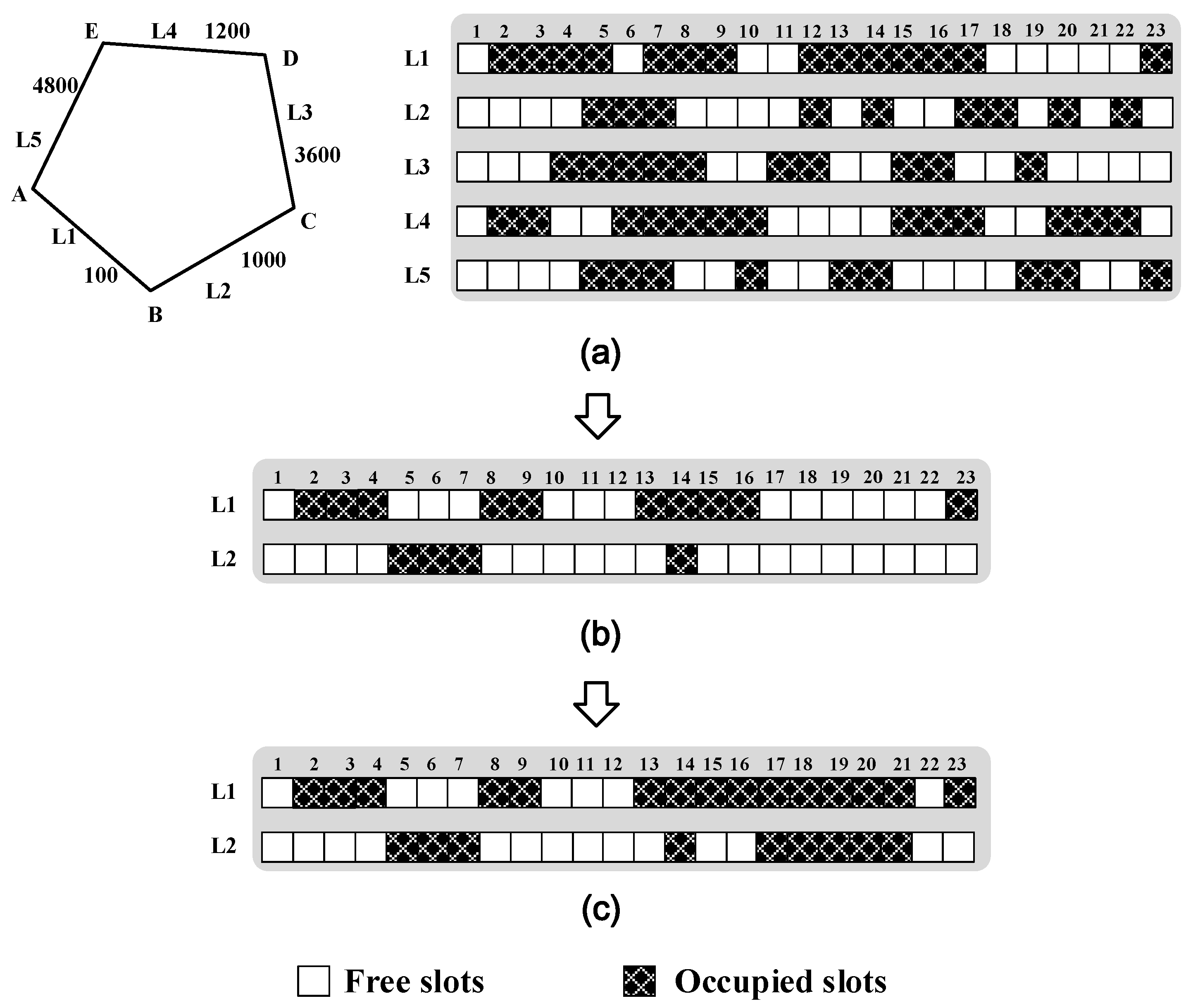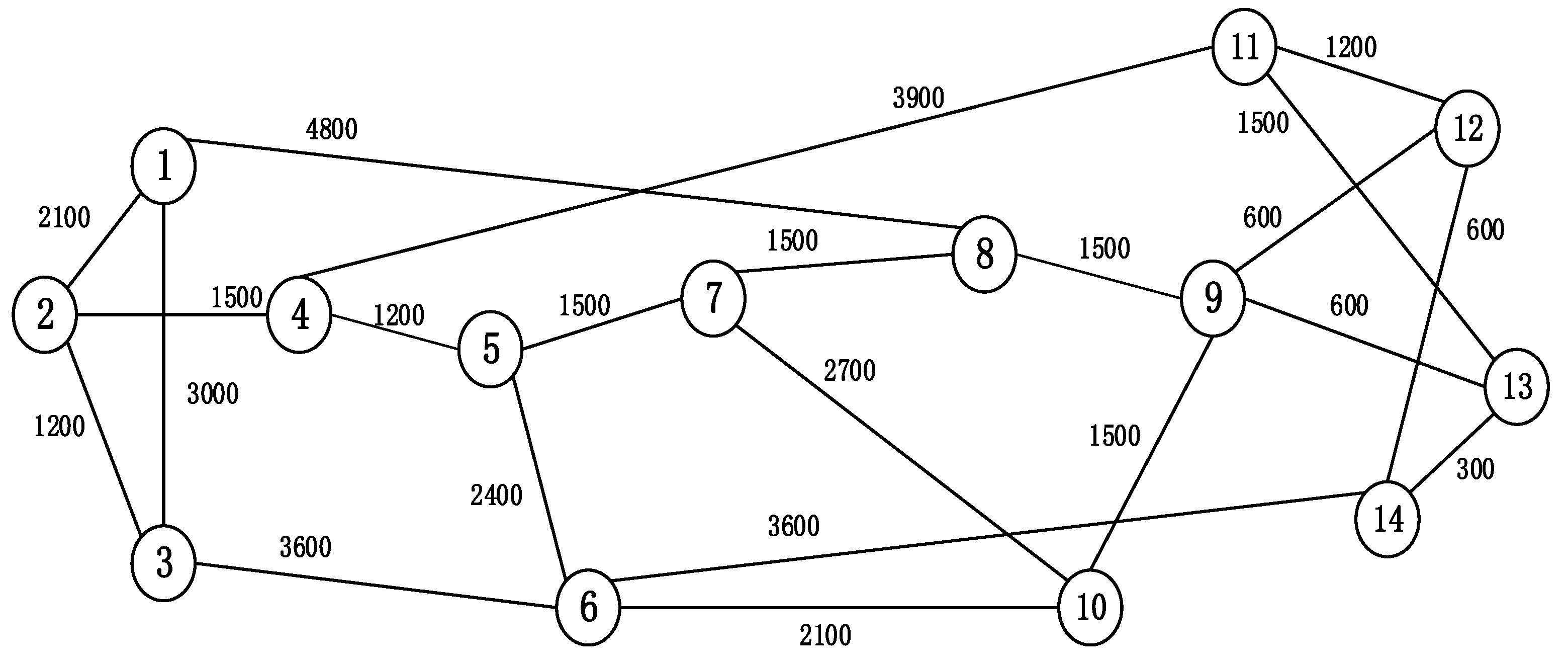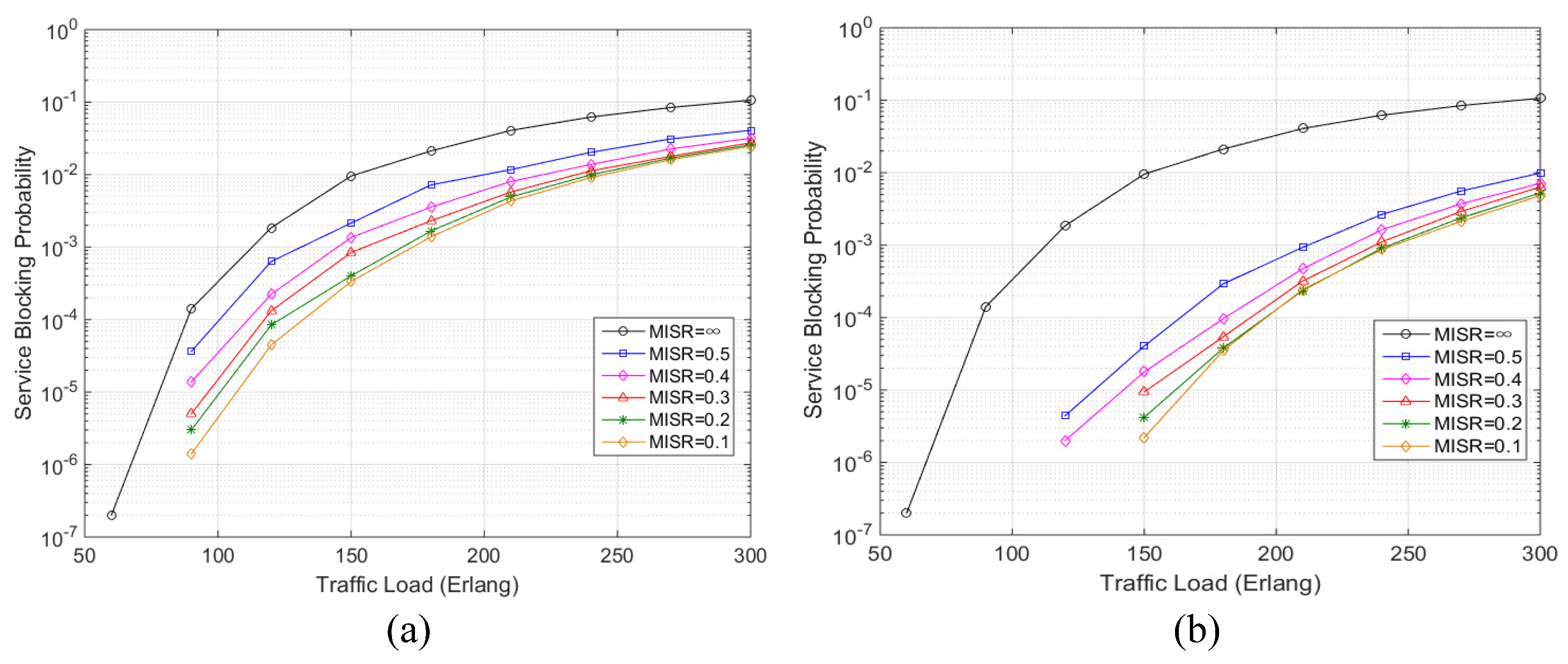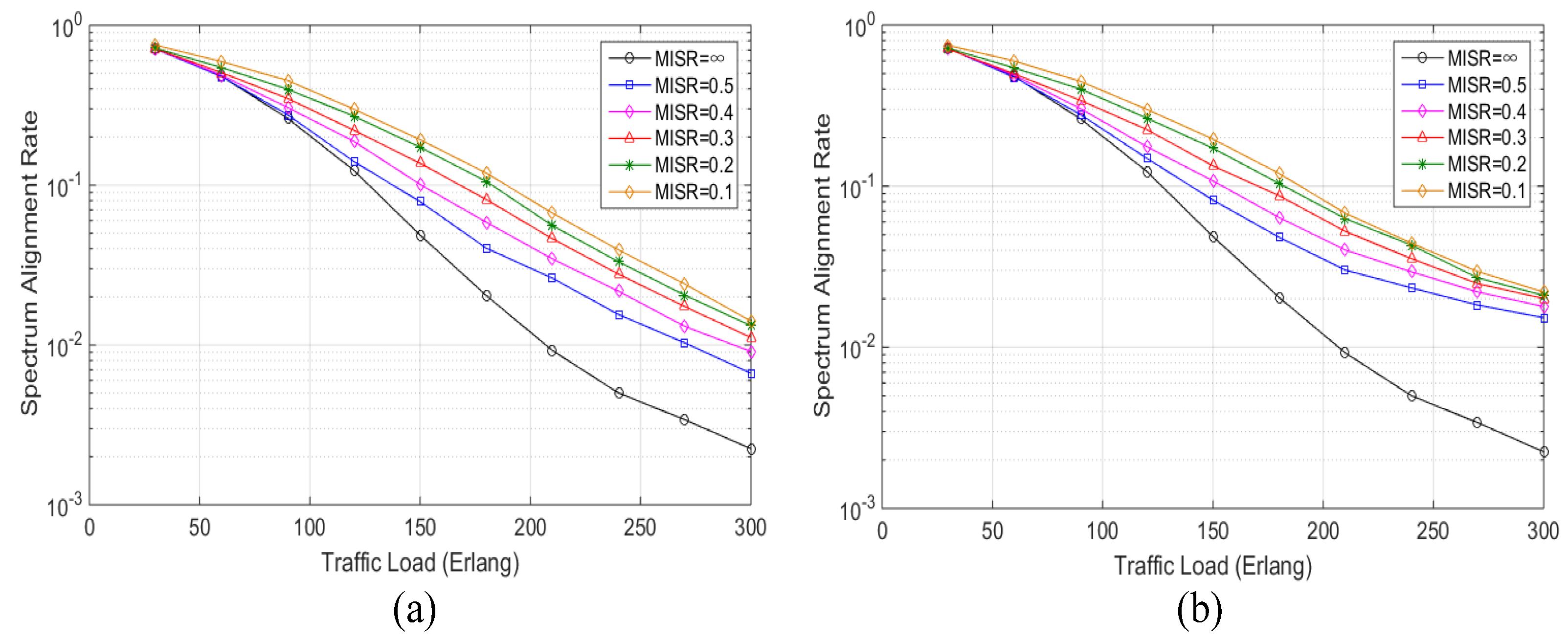Invalid-Resource-Aware Spectrum Assignment for Advanced-Reservation Traffic in Elastic Optical Network
Abstract
1. Introduction
2. The Network Modeling for the Proposed AR-ISA Algorithm
3. Details of the Proposed Advanced-Reservation-Based Invalid-Spectrum-Aware Resource Allocation Algorithm
| Algorithm 1. Details of the proposed AR-ISA algorithm. |
| AR-ISA Algorithm |
| 1: Compute K shortest-paths for each node pair in the network 2: Set a MISR for the algorithm 3: while network is running do 4: When a service R arrives 5: Select K pre-computed paths for R as its candidate paths 6: Calculate the modulate level and the amount of the needed FSs on each candidate path for R 7: for one path p in the K candidate paths do 8: Calculate the ISR along p 9: If the calculated ISR is larger than pre-set MISR then 10: Postpone R according to the time interval between two successive services 11: end if 12: Find available FSs on P for R 13: if available FSs are found on p then 14: Allocate the found FSs to R 15: end if 16: break 17: end for 18: If spectrum allocation for R is unsuccessful then 19: Do spectrum fragmentation for the existing services 20: for one path pin the K candidate paths do 21: Find available FSs on P for R 22: if available FSs are found on p then 23: Allocate the found FSs to R 24: end if 25: break 26: end for 27: end if 28: If spectrum allocation for R is unsuccessful then 29: Block R 30: end if 31: Update the network 32: end while |
4. Performance Evaluation
5. Conclusions
Author Contributions
Funding
Acknowledgments
Conflicts of Interest
References
- Sahu, H.; Hungyo, M. Introduction to SDN and NFV. In Innovations in Software-Defined Networking and Network Functions Virtualization; IGI Global: Hershey, PA, USA, 2018; pp. 1–25. [Google Scholar]
- Hsu, C.F.; Chang, Y.C.; Sie, S.C. Graph-model-based dynamic routing and spectrum assignment in elastic optical networks. IEEE/OSA J. Opt. Commun. Netw. 2016, 8, 507–520. [Google Scholar] [CrossRef]
- Gerstel, O.; Jinno, M.; Lord, A.; Yoo, S. Elastic optical networking: A new dawn for the optical layer? IEEE Commun. Mag. 2012, 50, s12–s20. [Google Scholar] [CrossRef]
- Christodoulopoulos, K.; Tomkos, I.; Varvarigos, E. Elastic bandwidth allocation in flexible OFDM-based optical networks. J. Lightwave Technol. 2011, 29, 1354–1366. [Google Scholar] [CrossRef]
- Liu, X.; Gong, L.; Zhu, Z. Design integrated RSA for multicast in elastic optical networks with a layered approach. In Proceedings of the IEEE Global Communications Conference (GLOBECOM), Atlanta, GA, USA, 9–13 December 2013; pp. 2346–2351. [Google Scholar]
- Wang, Y.; Cao, X.; Pan, Y. A study of the routing and spectrum allocation in spectrum-sliced elastic optical path networks. In Proceedings of the IEEE INFOCOM, Shanghai, China, 10–15 April 2011; pp. 1503–1511. [Google Scholar]
- Mahala, N.; Thangaraj, J. Spectrum Assignment using Prediction in Elastic Optical Networks. In Proceedings of the 2019 10th International Conference on Computing, Communication and Networking Technologies (ICCCNT), Kanpur, India, 6–8 July 2019. [Google Scholar]
- Yaghubi-Namaad, M.; Rahbar, A.G.; Alizadeh, B. Adaptive modulation and flexible resource allocation in space-division- multiplexed elastic optical networks. IEEE/OSA J. Opt. Commun. Netw. 2018, 10, 240–251. [Google Scholar] [CrossRef]
- Arpanaei, F.; Ardalani, N.; Beyranvand, H.; Alavian, S.A. Three-Dimensional Resource Allocation in Space Division Multiplexing Elastic Optical Networks. IEEE/OSA J. Opt. Commun. Netw. 2018, 10, 959–974. [Google Scholar] [CrossRef]
- Zheng, W.; Jin, Y.; Sun, W.; Guo, W.; Hu, W. On the spectrum efficiency of bandwidth-variable optical OFDM transport networks. In Proceedings of the Conference on Optical Fiber Communication (OFC/NFOEC), Collocated National Fiber Optic Engineers Conference, San Diego, CA, USA, 21–25 March 2010. [Google Scholar]
- Chatterjee, B.C.; Sarma, N.; Oki, E. Routing and Spectrum Allocation in Elastic Optical Networks: A Tutorial. IEEE Commun. Surv. Tutor. 2015, 17, 1776–1800. [Google Scholar] [CrossRef]
- Jinno, M.; Kozicki, B.; Takara, H.; Watanabe, A.; Sone, Y.; Tanaka, T.; Hirano, A. Distance-adaptive spectrum resource allocation in spectrum-sliced elastic optical path network. IEEE Commun. Mag. 2010, 48, 138–145. [Google Scholar] [CrossRef]
- Ding, Z.; Xu, Z.; Zeng, X.; Ma, T.; Yang, F. Hybrid routing and spectrum assignment algorithms based on distance-adaptation combined co-evolution and heuristics in elastic optical networks. Opt. Eng. 2014, 53, 046105. [Google Scholar] [CrossRef]
- Wright, P.; Parker, M.C.; Lord, A. Minimum- and maximum-entropy routing and spectrum assignment for flexgrid elastic optical networking. IEEE/OSA J. Opt. Commun. Netw. 2015, 7, A66–A72. [Google Scholar] [CrossRef]
- Jia, W.B.; Xu, Z.Q.; Ding, Z.; Wang, K. An efficient routing and spectrum assignment algorithm using prediction for elastic optical networks. In Proceedings of the International Conference on Information System and Artificial Intelligence (ISAI), HongKong, China, 24–26 June 2016. [Google Scholar]
- Beyranvand, H.; Salehi, J.A. A Quality-of-Transmission aware dynamic routing and spectrum assignment scheme for future elastic optical networks. J. Lightwave Technol. 2013, 31, 3043–3054. [Google Scholar] [CrossRef]
- Patel, A.N.; Ji, P.N.; Jue, J.P.; Wang, T. Defragmentation of transparent Flexible optical WDM (FWDM) networks. In Proceedings of the Optical Fiber Communication Conference and Exposition and the National Fiber Optic Engineers Conference, Los Angeles, CA, USA, 6–10 March 2011. [Google Scholar]
- Zhang, M.; Yin, Y.; Proietti, R.; Zhu, Z.; Yoo, S.J.B. Spectrum defragmentation algorithms for elastic optical networks using hitless spectrum retuning techniques. In Proceedings of the Optical Fiber Communication Conference and Exposition and the National Fiber Optic Engineers Conference (OFC/NFOEC), Anaheim, CA, USA, 17–21 March 2013. [Google Scholar]
- Chen, X.; Jukan, A.; Gumaste, A. Multipath de-fragmentation: Achieving better spectral efficiency in elastic optical path networks. In Proceedings of the IEEE INFOCOM, Turin, Italy, 14–19 April 2013; pp. 390–394. [Google Scholar]
- Cugini, F.; Paolucci, F.; Meloni, G.; Berrettini, G.; Secondini, M.; Fresi, F.; Sambo, N.; Poti, L.; Castoldi, P. Push-pull defragmentation without traffic disruption in flexible grid optical networks. J. Light. Technol. 2013, 31, 125–133. [Google Scholar] [CrossRef]
- Zhang, J.; Zhao, Y.; Yu, X.; Zhao, J. Priority-based defragmentation scheme in spectrum-efficient optical networks. In Proceedings of the The 10th International Conference on Optical Internet (COIN2012), Yokohama, Kanagawa, Japan, 29–31 May 2012. [Google Scholar]
- Zhang, M.; You, C.; Jiang, H.; Zhu, Z. Dynamic and adaptive bandwidth defragmentation in spectrum-sliced elastic optical networks with time-varying traffic. J. Light. Technol. 2014, 32, 1014–1023. [Google Scholar] [CrossRef]
- Naik, B.K.; Dutta, R.; Shashidhara, G.; Gowrishankar, R.; Sanagapati, S.S.S.; Bhyri, S.K.; Behere, P.P. Defragmentation of flexible dense wavelength division multiplexing (FDWDM) networks using wavelength tunability criterion. In Proceedings of the IEEE International Conference on Advanced Networks and Telecommunications Systems(ANTS), Bangalore, India, 6–9 November 2016; pp. 1–6. [Google Scholar]
- Yin, Y.; Wen, K.; Geisler, D.J.; Liu, R.; Yoo, S.J.B. Dynamic on-demand defragmentation in flexible bandwidth elastic optical networks. Opt. Express 2012, 20, 1798–1804. [Google Scholar] [CrossRef] [PubMed]
- Shakya, S.; Cao, X. Spectral Defragmentation in Elastic Optical Path Networks using Independent Sets. In Proceedings of the Optical Fiber Communication Conference and Exposition and the National Fiber Optic Engineers Conference (OFC/NFOEC), Anaheim, CA, USA, 17–21 March 2013. [Google Scholar]
- Sone, Y.; Hirano, A.; Kadohata, A.; Jinno, M.; Ishida, O. Routing and spectrum assignment algorithm maximizes spectrum utilization in optical networks. In Proceedings of the 37th European Conference and Exhibition on Optical Communication, Geneva, Switzerland, 18–22 September 2011. [Google Scholar]
- Wang, R.; Mukherjee, B. Spectrum management in heterogeneous bandwidth networks. Opt. Switch. Netw. 2014, 11, 83–91. [Google Scholar] [CrossRef]
- Qiu, Y.; Xu, J. Efficient Hybrid Grouping Spectrum Assignment to Suppress Spectrum Fragments in Flexible Grid Optical Networks. J. Light. Technol. 2017, 35, 2823–2832. [Google Scholar] [CrossRef]
- Qiu, Y. An efficient spectrum assignment algorithm based on variable-grouping mechanism for flexgrid optical networks. Opt. Switch. Netw. 2017, 24, 39–46. [Google Scholar] [CrossRef]
- Qiu, Y. Group-based spectrum assignment in dynamic flex-grid optical networks. Opt. Fiber Technol. 2013, 19, 437–445. [Google Scholar] [CrossRef]
- Qiu, Y. Resource-partitioned spectrum assignment to realize efficient multicasting for flexible grid optical networks. Opt. Fiber Technol. 2019, 53, 102067. [Google Scholar] [CrossRef]
- Ruan, L.; Xiao, N. Survivable multipath routing and spectrum allocation in OFDM-based flexible optical networks. IEEE/OSA J. Opt. Commun. Netw. 2013, 5, 172–182. [Google Scholar] [CrossRef]
- Liu, M.; Tornatore, M.; Mukherjee, B. Survivable traffic grooming in elastic optical networks—Shared protection. J. Lightwave Technol. 2013, 31, 903–909. [Google Scholar] [CrossRef]
- Patel, A.; Jue, J. Routing and scheduling for variable bandwidth advance reservation. IEEE/OSA J. Opt. Commun. Netw. 2011, 3, 912–923. [Google Scholar] [CrossRef]
- Chen, H.; Zhao, Y.; Zhang, J. Static provisioning for advanced reservation in elastic optical networks. In Proceedings of the 2017 16th International Conference on Optical Communications and Networks (ICOCN), Wuzhen, China, 7–10 August 2017. [Google Scholar]
- Li, X.; Yuan, J.; Zhang, Q.; Ren, Z.; Yang, L. Farsighted Spectrum Resource Assignment Method for Advance Reservation Requests in Elastic Optical Networks. IEEE Access 2019, 7, 167836–167846. [Google Scholar] [CrossRef]
- Li, Y.; Zhang, Q.; Xin, X.; Tian, Q.; Liu, N.; Tao, Y.; Cao, G.; Tian, F.; Wang, Y.; Wang, Z.; et al. Dynamic Service Provisioning Algorithm Based on Degree of Spectrum-Time Fragmentation of AR Requests in Elastic Optical Networks. In Proceedings of the 2019 18th International Conference on Optical Communications and Networks (ICOCN), Huangshan, China, 5–8 August 2019. [Google Scholar]
- Sugihara, S.; Hirota, Y.; Fujii, S.; Tode, H.; Watanabe, T. Dynamic Resource Allocation for Immediate and Advance Reservation in Space-Division-Multiplexing-Based Elastic Optical Networks. IEEE/OSA J. Opt. Commun. Netw. 2017, 9, 183–197. [Google Scholar] [CrossRef]
- Lu, W.; Zhu, Z. Dynamic Service Provisioning of Advance Reservation Requests in Elastic Optical Networks. J. Light. Technol. 2013, 31, 1621–1627. [Google Scholar] [CrossRef]
- Kaushik, N.R.; Figueira, S.M.; Chiappari, S.A. Flexible Time-Windows for Advance Reservation Scheduling. In Proceedings of the 14th IEEE International Symposium on Modeling, Analysis, and Simulation, Monterey, CA, USA, 11–14 September 2006; Volume 1, pp. 218–225. [Google Scholar]
- Hu, C.; Huai, J.; Wo, T. Flexible Resource Reservation Using Slack Time for Service Grid. In Proceedings of the 12th International Conference on Parallel and Distributed Systems—(ICPADS’06), Minneapolis, MN, USA, 12–15 July 2006; Volume 1, pp. 327–334. [Google Scholar]
- Chen, H.; Zhao, Y.; Zhang, J.; He, R.; Wang, W.; Wu, J.; Wang, Y.; Ji, Y.; Zheng, H.; Lin, Y.; et al. Time-Spectrum Consecutiveness Based Scheduling with Advance Reservation in Elastic Optical Networks. IEEE Commun. Lett. 2015, 19, 70–73. [Google Scholar] [CrossRef]
- Bocoi, A.; Schuster, M.; Rambach, F.; Kiese, M.; Bunge, C.A.; Spinnler, B. Reach-dependent capacity in optical networks enabled by OFDM. In Proceedings of the Conference on Optical Fiber Communication—Incudes Post Deadline Papers, San Diego, CA, USA, 22–26 March 2009. [Google Scholar]
- Fan, Z.; Qiu, Y.; Chan, C.K. Dynamic Multipath Routing with Traffic Grooming in OFDM Based Elastic Optical Path Networks. J. Lightwave Technol. 2015, 33, 275–281. [Google Scholar] [CrossRef]
- Zhao, J.; Wymeersch, H.; Agrell, E. Nonlinear impairment-aware static resource allocation in elastic optical networks. J. Lightwave Technol. 2015, 33, 4554–4564. [Google Scholar] [CrossRef]
- Semrau, D.; Xu, T.; Shevchenko, N.A.; Paskov, M.; Alvarado, A.; Killey, R.I.; Bayvel, P. Achievable information rates estimates in optically amplified transmission systems using nonlinearity compensation and probabilistic shaping. Opt. Lett. 2017, 42, 121–124. [Google Scholar] [CrossRef]
- Karanov, B.; Xu, T.; Shevchenko, N.A.; Lavery, D.; Killey, R.I.; Bayvel, P. Span length and information rate optimisation in optical transmission systems using single-channel digital backpropagation. Opt. Express 2017, 25, 25353–25362. [Google Scholar] [CrossRef]
- Fabbri, S.; Stephens, M.F.; McCarthy, M.E.; Perentos, A.; Phillips, I.D.; Lavery, D.; Liga, G.; Maher, R.; Harper, P.; Doran, N.J.; et al. 4 Tbit/s transmission reach enhancement using 10 × 400 Gbit/s super-channels and polarization insensitive dual band optical phase conjugation. J. Lightwave Technol. 2016, 34, 1–7. [Google Scholar]
- Liga, G.; Alvarado, A.; Agrell, E.; Secondini, M.; Killey, R.I.; Bayvel, P. Optimum detection in presence of nonlinear distortions with memory. In Proceedings of the 2015 European Conference on Optical Communication (ECOC), Valencia, Spain, 27 September–1 October 2015. [Google Scholar]
- Prilepsky, J.E.; Derevyanko, S.A.; Blow, K.J.; Gabitov, I.; Turitsyn, S.K. Nonlinear Inverse Synthesis and Eigenvalue Division Multiplexing in Optical Fiber Channels. Phys. Rev. Lett. 2014, 113, 013901. [Google Scholar] [CrossRef] [PubMed]




| Transmission Range (km) | Modulation Level(bit/Hz) | Modulation Format |
|---|---|---|
| 9600 | 1 | BPSK |
| 4800 | 2 | QPSK |
| 2400 | 3 | 8-QAM |
| 1200 | 4 | 16-QAM |
| Full Name | Abbreviation |
|---|---|
| EONs | Elastic optical networks |
| RSA | Routing and spectrum allocation |
| AR-ISA | Advanced-reservation-based invalid-spectrum-aware |
| ISR | Invalid spectrum rate |
| WDM | Wavelength division multiplexing |
| SRU | Spectrum resource usage |
| DSTF | Degree of spectrum-time fragmentation |
| RMSA | Routing, modulation and spectrum assignment |
| TSC | Time-spectrum consecutiveness |
| FSs | Frequency slots |
| MISR | Maximum invalid spectrum ratio |
| NSFNET | National science foundation network |
| Parameters | Settings |
|---|---|
| Network topology | NSF-Net |
| K, number of candidate paths | 3 |
| F, number of frequency slots | 320 |
| Bandwidth of one frequency slot | 12.5 GHz |
| Number of guard band | 1 |
| Optional modulation formats | BPSK, QPSK, 8-QAM, 16-QAM |
| Bits per symbol of different modulation formats | 1, 2, 3, 4 |
| Reachable distance of different modulation formats (km) | 9600, 4800, 2400, 1200 |
| Type of services (Gb/s) | 50, 100, 150, 200 |
| Proportion of different types of services | 1:1:1:1 |
| Arrival rate of services | Poisson distribution model |
| Duration time of each service | Negative exponential distribution |
| Number of services per simulation | 5 × 106 |
© 2020 by the authors. Licensee MDPI, Basel, Switzerland. This article is an open access article distributed under the terms and conditions of the Creative Commons Attribution (CC BY) license (http://creativecommons.org/licenses/by/4.0/).
Share and Cite
He, S.; Qiu, Y.; Xu, J. Invalid-Resource-Aware Spectrum Assignment for Advanced-Reservation Traffic in Elastic Optical Network. Sensors 2020, 20, 4190. https://doi.org/10.3390/s20154190
He S, Qiu Y, Xu J. Invalid-Resource-Aware Spectrum Assignment for Advanced-Reservation Traffic in Elastic Optical Network. Sensors. 2020; 20(15):4190. https://doi.org/10.3390/s20154190
Chicago/Turabian StyleHe, Shufang, Yang Qiu, and Jing Xu. 2020. "Invalid-Resource-Aware Spectrum Assignment for Advanced-Reservation Traffic in Elastic Optical Network" Sensors 20, no. 15: 4190. https://doi.org/10.3390/s20154190
APA StyleHe, S., Qiu, Y., & Xu, J. (2020). Invalid-Resource-Aware Spectrum Assignment for Advanced-Reservation Traffic in Elastic Optical Network. Sensors, 20(15), 4190. https://doi.org/10.3390/s20154190





